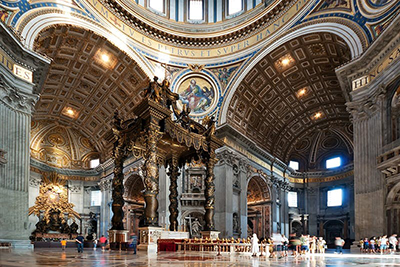Anytime a person gets to the entrance of the largest church in the world,one can not hide the surprise that hits them. From the entrance to the interior of the church, is epic art. The walls, the shrines, the altar, name them. All over is art and more art.
This is the handy work of a famous artist by the name Raphael.His painting are high end and his work is evident at St Peter's Basilica. The iconic church is situated on the tomb of St Peter's, one who was an apostle of Jesus Christ. The church was designed to mimic the early Constantinian church. Its architectural work combines the old ad the new state of art. This has made St. Peter's Basilica to be, not only a church, but also a tourist attraction site. The concrete used to build the church was that of the 16th century. This concrete is so strong such that can withstand earthquakes. The travertine stone is held by seven rings, which are internal. This rings helped to girdle the structure making it even more stronger.
Several iron chains are set in several different places on top of the church. These chains help in keeping the cupola steady. In return, those people who wish to have a view of Rome from the top of the building can have it without a worry. Raphael used a very unique style, which he ensured that it would make the church to be outstanding. Unlike other churches that use the centralized style, Raphael used the central plan construction style and the basilica construction style. This made the church to be outstanding and represented the nature of God, his eternal and perfection nature, in the central plan. The basilica style, on the other hand, represented the practicality of the central plan. Its long axis points to the altar, which symbolises the presence of God. These two combinations make the church to have a homier feel to the congregation.
Raphael included unique features in building the large church. Inside, there would be a combination of light and shadow. Faithfuls would first be met by a shadowy entrance but the more the got closer to the altar, light would go on increasing. At the altar, where the burial place of St. Peters lies, is where full light shines. The floors of the church are decorated with marbles which enhances the effects of the light. At the aisle on the left is the painting of the Transfiguration. Few meters from the transfiguration is the Clement X111 funerary monument. High in the monument, the pope,s sculpture is mounted with him praying while kneeling. There are also statues of the saints who founded the church, just in the vicinity of the church. These are just some of the sculptures that are found in the church among many others.
Raphael did not work complete the work alone. Some of his works was inspired by other architects who were before him, while some of his work was completed by those who came after him. Architects Leone Battista Alberti and Bernardo Rossellino were the pioneers of building St.Peter's Basilica. Donato Bramante, then designed the church which later on saw it begin to be built,following his design. Giuliano da Sangallo and Fra Giocondo later on followed and worked to a great extent with Raphael. Michelangelo, after being preceded by other architects, later on saw the completion of St.Peter's Basilica as it is today.
Raphael was primarily inspired by his father, who was a painter. Later on, Raphael unleashed his artistic nature when he saw the works of Fra Bartolommeo, Masaccio and Leonardo da Vinci. These were the most significant Italian artists at the time. He looked closely into their works and drew a great interest and a motivation to outdo them all. This paid off because in later years, Raphael was able to bring out extraordinary paintings that were archived for future generations to see and relate to.




